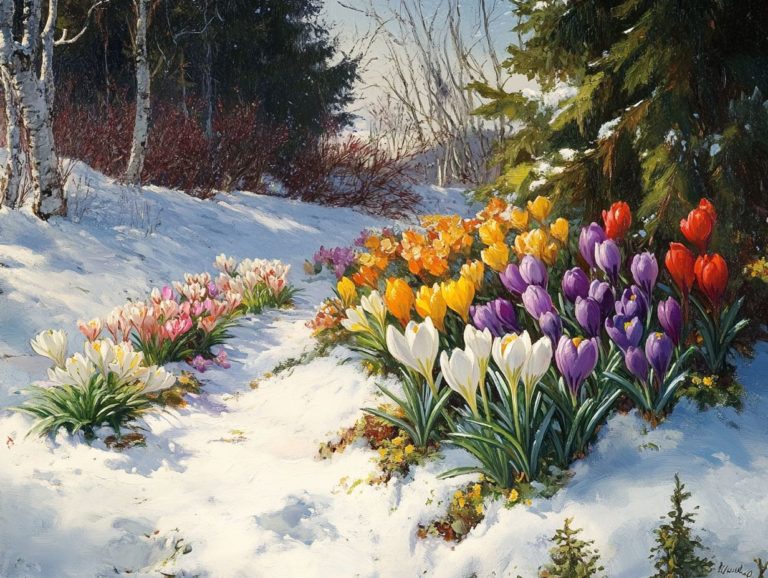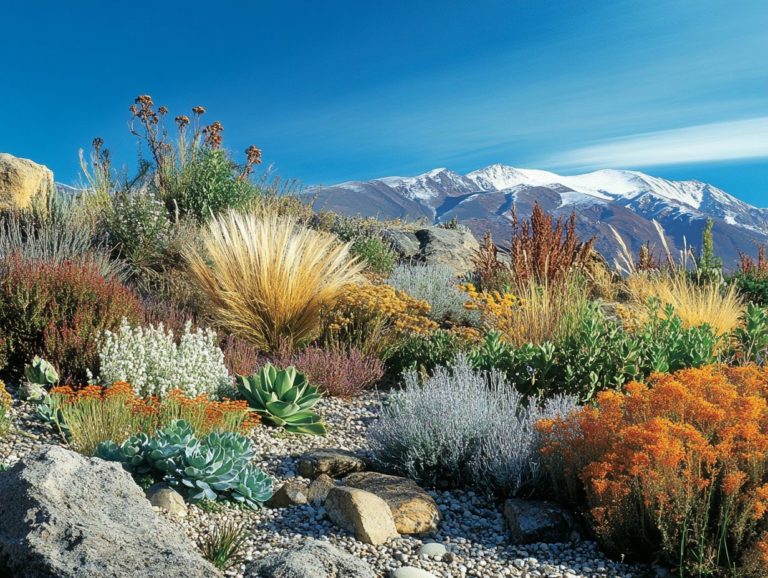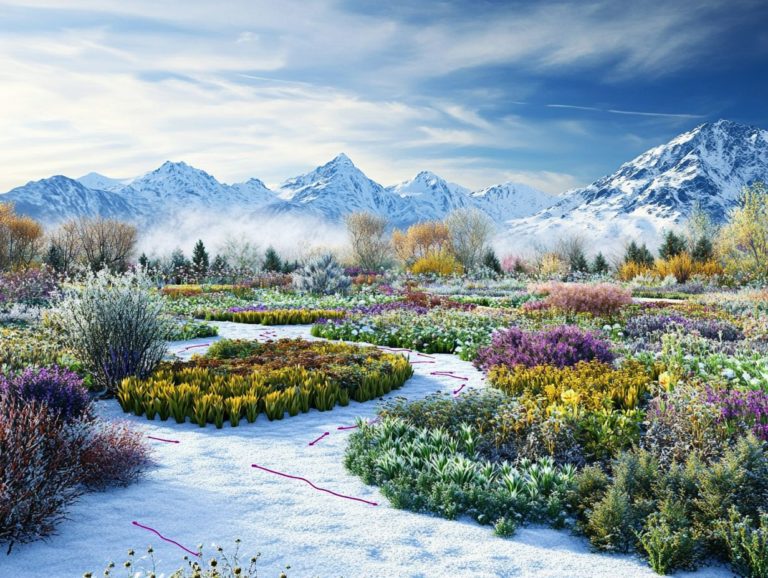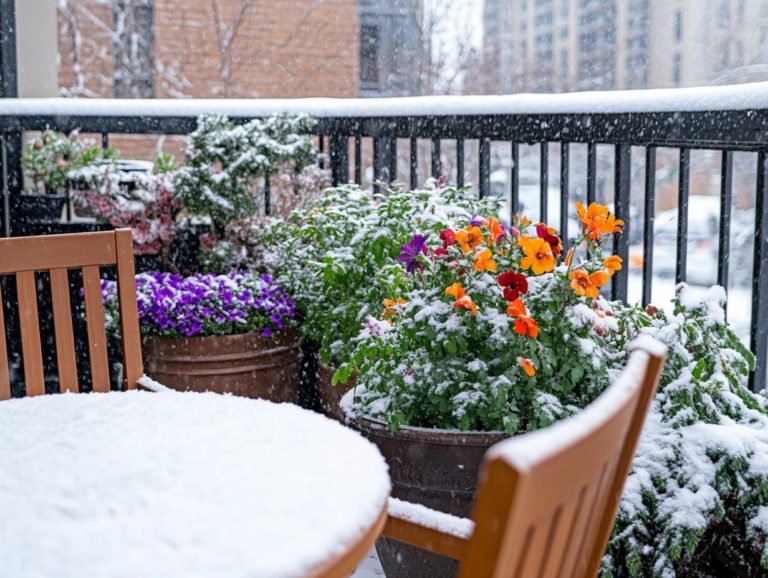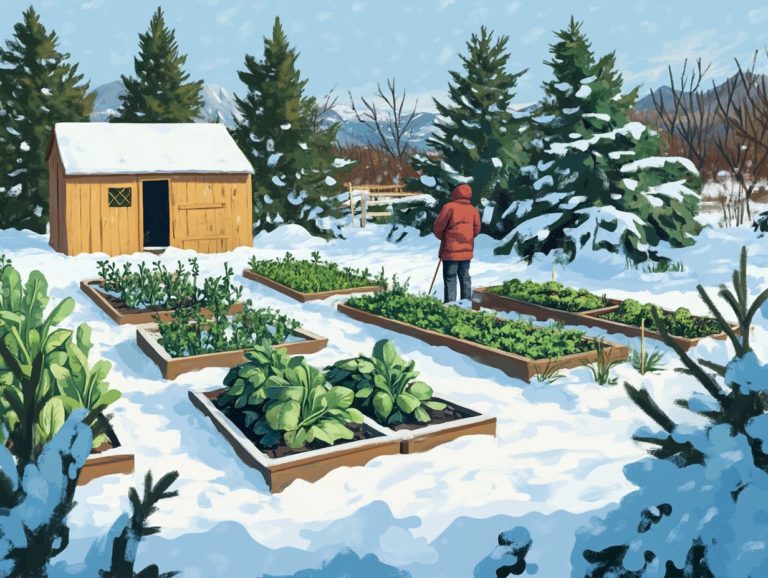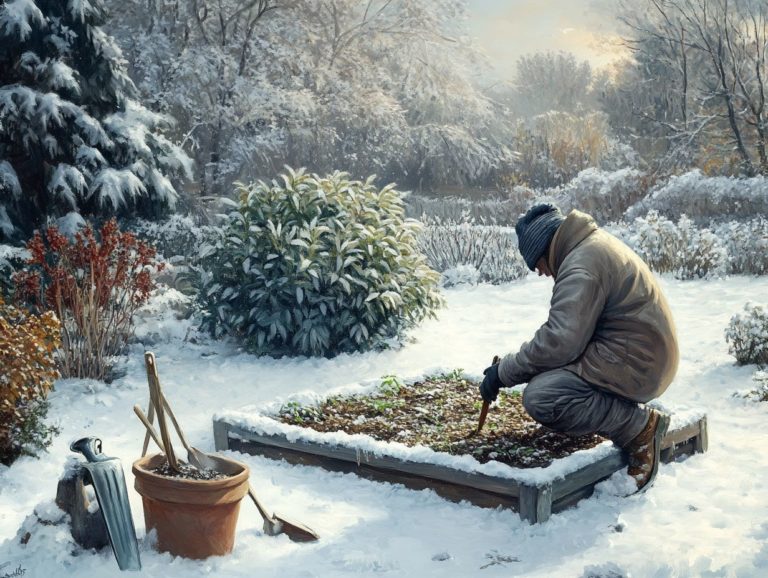Best Climbing Plants for Cold Climates
When enhancing your garden in colder climates, climbing plants can truly transform your space!
These remarkable plants not only introduce vertical interest and beauty, but also offer insulation and energy efficiency. They can turn your outdoor area into an inviting retreat throughout the year!
This guide delves into the finest climbing plants suited for chillier weather, from the vibrant Virginia Creeper to the enchanting Wisteria. You ll uncover essential tips for selecting, maintaining, and maximizing the aesthetic charm of these resilient vines in your garden.
Contents
- Key Takeaways:
- 1. Virginia Creeper
- 2. Boston Ivy
- 3. Climbing Hydrangea
- 4. Honeysuckle
- 5. Trumpet Vine
- 6. Clematis
- 7. Wisteria
- 8. Climbing Roses
- 9. Climbing Hyacinth Bean
- 10. Chocolate Vine
- 11. Climbing Hyacinth
- 12. Purple Passionflower
- 13. Dutchman’s Pipe
- 14. Climbing Snapdragon
- 15. Climbing Nasturtium
- What Are Climbing Plants and Why Are They Ideal for Cold Climates?
- What Are the Key Factors to Consider When Choosing Climbing Plants for Cold Climates?
- How Can Climbing Plants Enhance the Aesthetics of a Garden in a Cold Climate?
- What Are Some Tips for Maintaining Climbing Plants in a Cold Climate?
- How Can Climbing Plants Help with Insulation and Energy Efficiency in a Cold Climate?
- Frequently Asked Questions
- What are the best climbing plants for cold climates?
- What should I consider when choosing climbing plants for a cold climate?
- Can climbing plants survive in freezing temperatures?
- How can I protect climbing plants in cold climates?
- What are some fast-growing climbing plants for cold climates?
- Can I grow fruit-bearing climbing plants in a cold climate?
Key Takeaways:
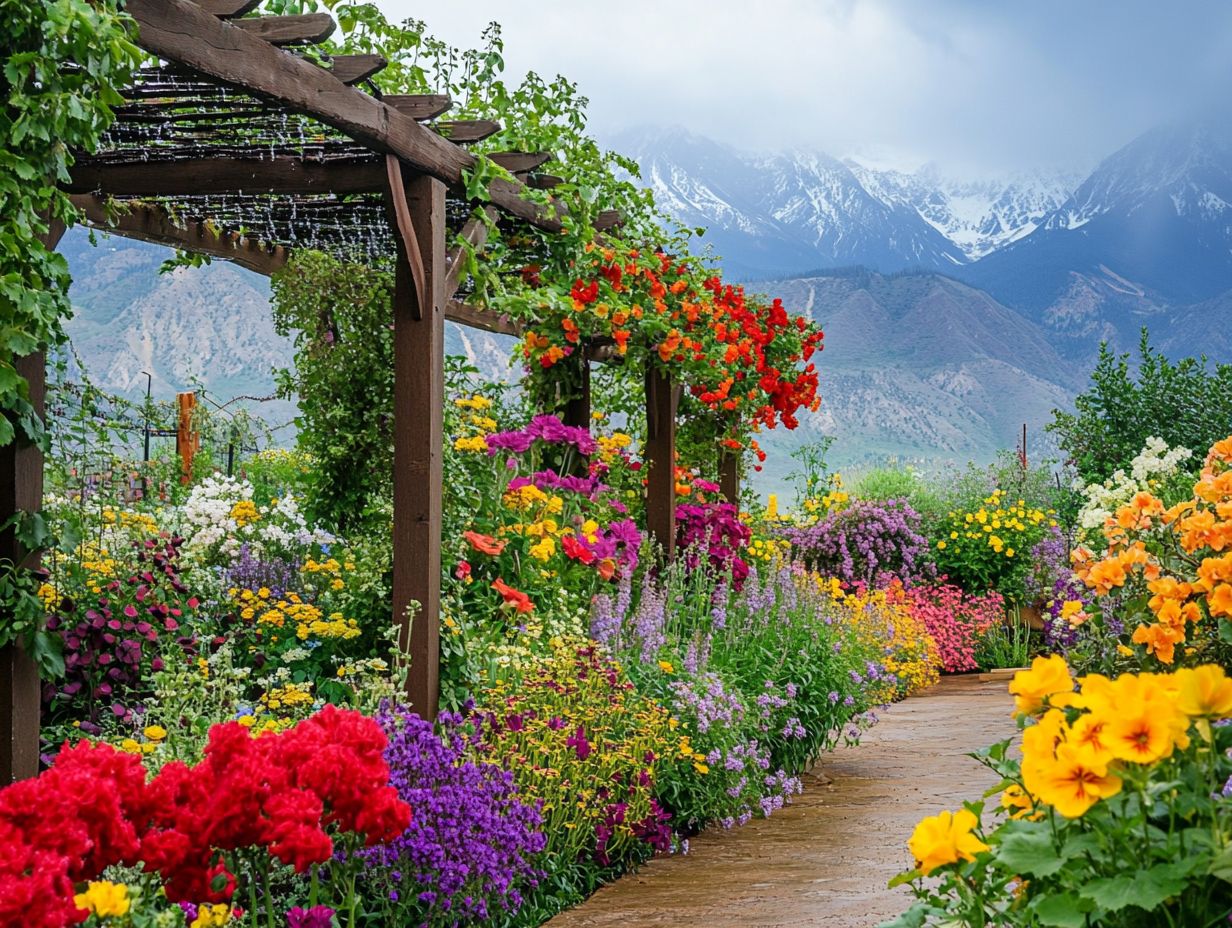
- Virginia Creeper, Boston Ivy, and Climbing Hydrangea are hardy, low-maintenance climbing plants that thrive in cold climates.
- Climbing plants add beauty and vertical interest to gardens, and they insulate homes while providing energy efficiency.
- Proper selection and maintenance are key when choosing climbing plants for cold climates. Consider factors like hardiness, sunlight, and soil conditions.
1. Virginia Creeper
Virginia Creeper, or Parthenocissus quinquefolia if you want to impress your friends, is a fantastic climbing plant that flourishes across various garden zones. This makes it an ideal pick for gardeners like you who are on the hunt for cold-hardy vines to elevate your landscape!
With its lush greenery, it draws in pollinators and enhances the biodiversity of your garden. Known for its vigorous growth, this native beauty fits seamlessly into a myriad of garden styles.
As it ascends, Virginia Creeper employs thin stems that effortlessly grasp onto structures, fences, or tree trunks. You’ll enjoy its rich green leaves that transform into a breathtaking display of reds and oranges in autumn!
Caring for it is a breeze. It thrives in both sun and shade and is quite drought-tolerant. A little regular watering will encourage optimal growth. Its hardiness means it can brave colder temperatures, making it a resilient addition to your garden.
This plant also plays a vital role in your garden’s ecosystem by attracting bees and other beneficial pollinators. It nurtures a flourishing environment for both plants and wildlife!
2. Boston Ivy
Boston Ivy, or Parthenocissus tricuspidata, is a remarkable choice for your garden! It thrives in colder climates, making it one of the finest cold-hardy vines for crafting visually captivating vertical gardens.
This intriguing vine climbs effortlessly, using tiny suckers to cling to surfaces. It offers lush foliage that transforms into vibrant shades of red and orange in fall.
Unlike clematis or climbing roses, which often demand meticulous care, Boston Ivy adapts to various soil types and requires minimal attention once it’s settled in!
Its resilience allows it to beautifully cloak walls, trellises, and fences. The rich seasonal changes bring striking interest in winter, while its dense growth provides a natural habitat for wildlife.
3. Climbing Hydrangea
Climbing Hydrangea, or Hydrangea anomala petiolaris, is a remarkable and resilient flowering vine that dazzles even in cooler climates! It provides stunning aesthetics and winter interest that any garden designer or plant enthusiast would appreciate.
This versatile climber showcases creamy white lace-cap flowers that bloom in summer, offering delightful visual contrast against its lush green foliage. With the right care think well-drained soil and partial to full shade this vine thrives and can reach impressive lengths!
Its ability to cling to surfaces via aerial roots enhances its climbing prowess, turning any space into a picturesque vertical garden. As the seasons change, the vibrant green leaves transition to warm autumn hues, while its dormant branches maintain structure and interest throughout winter!
4. Honeysuckle
Honeysuckle, especially varieties like Lonicera sempervirens, is prized for its intoxicating fragrance. It also thrives as a climbing plant in colder climates, making it an exceptional choice for edible landscaping.
With delightful species such as Lonicera japonica and Lonicera tartarica, honeysuckle brings vibrant colors and enchanting scents. These plants attract bees, butterflies, and hummingbirds, boosting the variety of plants and animals in your garden.
Honeysuckles provide essential habitat while needing little maintenance. They flourish in well-drained soil and adapt to various light conditions.
Regular pruning encourages new growth and enhances their flowering. This makes them a stunning choice that adds both a beautiful look and ecological benefits.
5. Trumpet Vine
Trumpet Vine, or Campsis radicans, is a stunning flowering plant that captivates with its vibrant, trumpet-shaped flowers. Its vigorous growth makes it a favorite among climbing plants in various garden designs.
This remarkable vine showcases an impressive display of fiery orange and yellow blooms throughout the warmer months. It thrives in a wide range of conditions and needs minimal maintenance once established.
Imagine how it weaves around trellises and fences, adding drama and intrigue. It effortlessly brightens those dull spots in your garden.
Plus, Trumpet Vine plays a vital role in attracting hummingbirds, bringing life and movement to your outdoor spaces. It is also known for its resilience in colder climates, providing beauty and color even when temperatures drop.
This makes it a versatile choice for enthusiastic gardeners like you.
6. Clematis
Clematis, a captivating genus of climbing plants, offers many options that thrive in cold climates, including some of the best plants for shade gardens in cold climates. They excel at adding beautiful looks to any garden.
Picture the delicate blooms of ‘Jackmanii’, gracing your garden in mid-summer. Alongside the fragrant ‘Sweet Summer Love’, this variety offers a delightful display from late spring to fall.
Caring for these plants is refreshingly straightforward. With well-drained soil and a bit of thoughtful pruning, both novices and seasoned horticulturists can cultivate them effortlessly.
Clematis can transform trellises, fences, or arbors into breathtaking vertical displays. They add layers of texture and color, dramatically enhancing your outdoor aesthetic.
This versatility allows them to serve as privacy screens or striking focal points, seamlessly integrating into various landscaping styles.
7. Wisteria
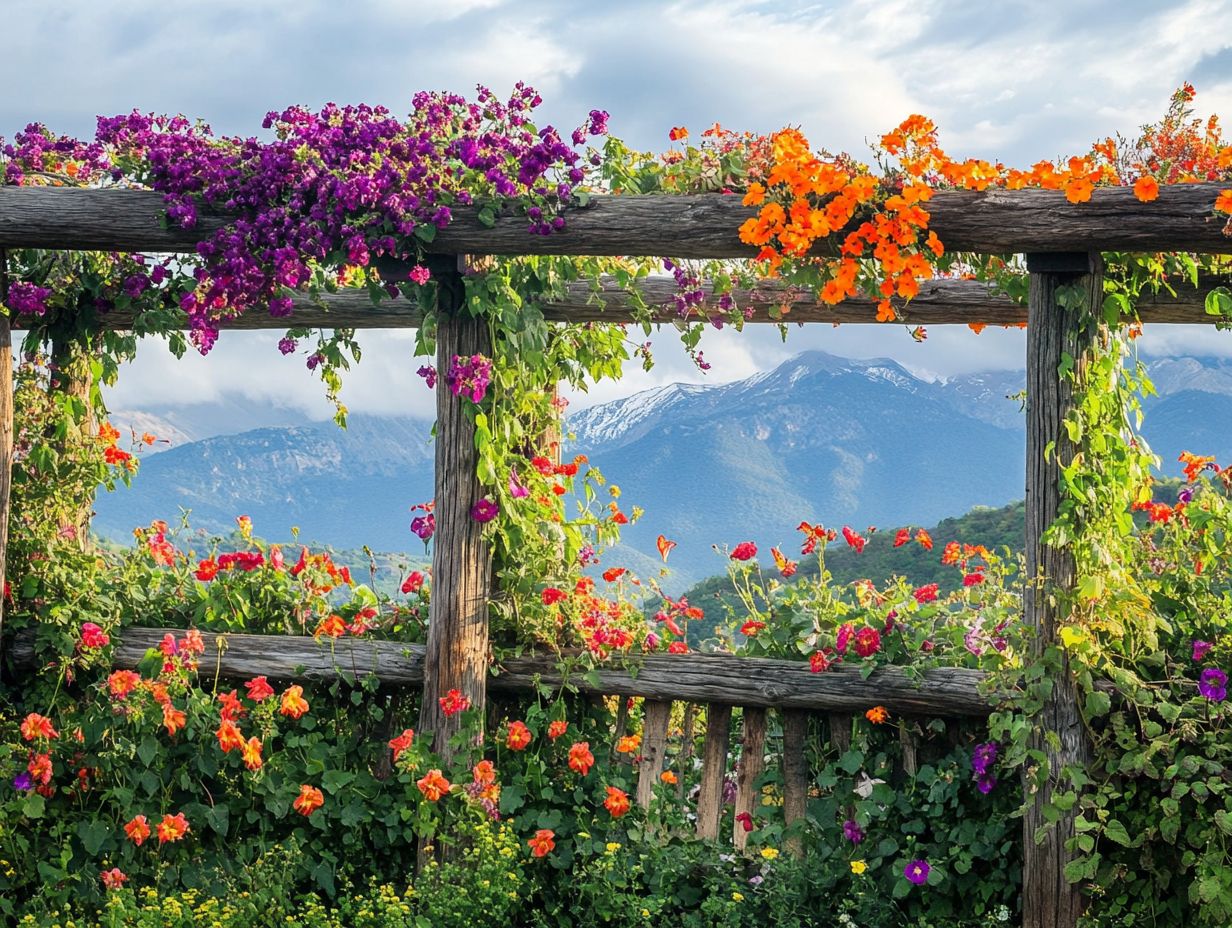
Wisteria, especially varieties like Wisteria floribunda, is celebrated for its breathtaking cascades of flowers. Its impressive climbing ability makes it perfect for adding dramatic flair to your landscape.
These stunning blooms will amaze anyone, often resembling opulent clusters of lilac or lavender. They are sure to draw admiration and attention from anyone who encounters them.
To flourish, wisteria demands well-draining soil, plenty of sunlight, and regular pruning to encourage vigorous growth. This ensures it maximizes its blooming potential.
Ideal spots for this magnificent vine include pergolas, trellises, or even as standalone focal points within landscaped areas. When thoughtfully positioned, wisteria can craft enchanting vertical gardens.
These gardens transform ordinary spaces into captivating retreats, perfect for relaxation or entertaining guests.
8. Climbing Roses
Climbing roses, with their captivating blooms and vigorous growth, are a timeless choice for elevating your garden design. They provide strong flowering choices that not only enhance your landscape but also offer winter interest.
These versatile plants boast a stunning array of colors. You can choose from vibrant reds, radiant pinks, soft yellows, and creamy whites allowing you to craft striking visual displays. Depending on the variety, blooming periods can differ; some may begin as early as spring and continue through the fall, providing nearly continuous color throughout the growing season.
For optimal growth, it’s essential for you to select a supportive structure, like trellises or arbors, and to maintain proper care through regular pruning and watering. By incorporating climbing roses into your garden designs that include edible landscaping, you’ll not only add height and vertical interest but also contribute to a varied and interesting garden that will leave a lasting impression.
9. Climbing Hyacinth Bean
Climbing Hyacinth Bean, or Lathyrus ochroleucus, is a well-regarded choice among cold-hardy vines. This stunning biennial vine transforms your garden with its vibrant foliage and exquisite flowers, making it a perfect addition to any garden design.
Its rapid growth and vigorous climbing nature allow it to gracefully twine around trellises, fences, or arbors, crafting a lush, green tapestry that beautifies any vertical space. The vivid purple and magenta flowers present a striking contrast against the rich green leaves, while the decorative seed pods add an extra layer of visual intrigue as the season progresses.
This beautiful vine fits well in many garden styles, thriving in full sun to partial shade and favoring well-draining soil. By ensuring regular watering and incorporating organic mulch, you not only retain moisture but also suppress weeds, optimizing growth and foliage health.
The climbing hyacinth bean is truly a rewarding choice for both novice and experienced gardeners alike.
10. Chocolate Vine
Chocolate Vine, or Akebia quinata, is a captivating climbing plant that you’ll love for its delightful fragrance and stunning blooms. This resilient vine thrives in a variety of conditions, whether in shady nooks or sun-drenched spots, taking advantage of the local climate and frost resistance.
Its unique five-lobed leaves (leaves divided into five parts) add an intriguing texture that persists through the seasons. With its impressive ability to scale heights, it effortlessly integrates into trellises, arbors, or fences, crafting a lush green backdrop that enhances the beauty of surrounding flora.
You ll especially appreciate its flowering period, showcasing a variety of hardy flowering options that are also cold hardy vines, as the blooms attract vital pollinators like bees and butterflies, contributing to a thriving ecosystem that includes native plants. With some care, such as occasional pruning, this versatile vine can flourish in your landscape, adding both aesthetic charm and ecological value, especially in frosty conditions.
11. Climbing Hyacinth
Climbing Hyacinth stands out for its delicious pods and beautiful flowers. It’s perfect for enhancing your edible garden!
With its delicate, fragrant blooms and lush foliage, this vine adds a striking visual dimension to your garden while offering delicious, nutritious pods ready for culinary exploration. By paying careful attention to its growing environment favoring well-drained soil and a sunny climbing spot you’ll encourage a thriving plant.
Pairing it with vibrant flowering companions, such as clematis, Kentucky wisteria, honeysuckle, and climbing hydrangea, or resilient evergreens creates captivating contrasts and fosters a diverse ecosystem. Incorporating organic mulch not only retains moisture but also enriches the soil, promoting robust growth and overall health for the climbing hyacinth and its surrounding allies.
12. Purple Passionflower
Purple Passionflower, or Passiflora incarnata, is a stunning climbing plant that captures attention with its intricate blooms and distinctive foliage. It’s a top choice for gardeners who appreciate hardy flowering options that add winter interest.
This remarkable plant exhibits impressive growth habits. It often reaches great heights and elegantly drapes trellises and arbors with its vibrant tendrils, making it perfect for those seeking vines that stick to surfaces. With a preference for sunny spots and well-drained soil, it requires minimal care, ensuring it’s a perfect fit for both novice and seasoned gardeners alike.
Beyond its ornamental appeal, the Purple Passionflower plays a vital role in attracting pollinators such as bees and butterflies, enriching the ecological harmony of your garden space. Let s not overlook its edible fruit, which opens up delightful possibilities for blending beauty with functionality in your landscaping designs.
13. Dutchman’s Pipe
Dutchman’s Pipe, or Aristolochia macrophylla, is an extraordinary climbing plant that enhances aesthetic appeal, particularly in arrangements that highlight organic gardening principles and adds winter interest to your garden design. It s ideal for anyone seeking hardy flowers that can withstand the chill of colder climates.
This remarkable vine features large, heart-shaped leaves. It also has distinctive, pipe-like flowers that bloom in shades of greenish-yellow, creating a striking visual contrast. You’ll find that the Dutchman’s Pipe thrives in various soil types, though it truly prefers well-drained, moist conditions and partial to full shade. Its adaptability allows it to flourish beautifully on trellises, fences, and pergolas, providing essential shade for other plants in your garden.
It’s not just beautiful; this plant also helps attract pollinators, such as butterflies and hummingbirds, contributing to a more vibrant garden ecosystem that you’ll surely appreciate.
14. Climbing Snapdragon
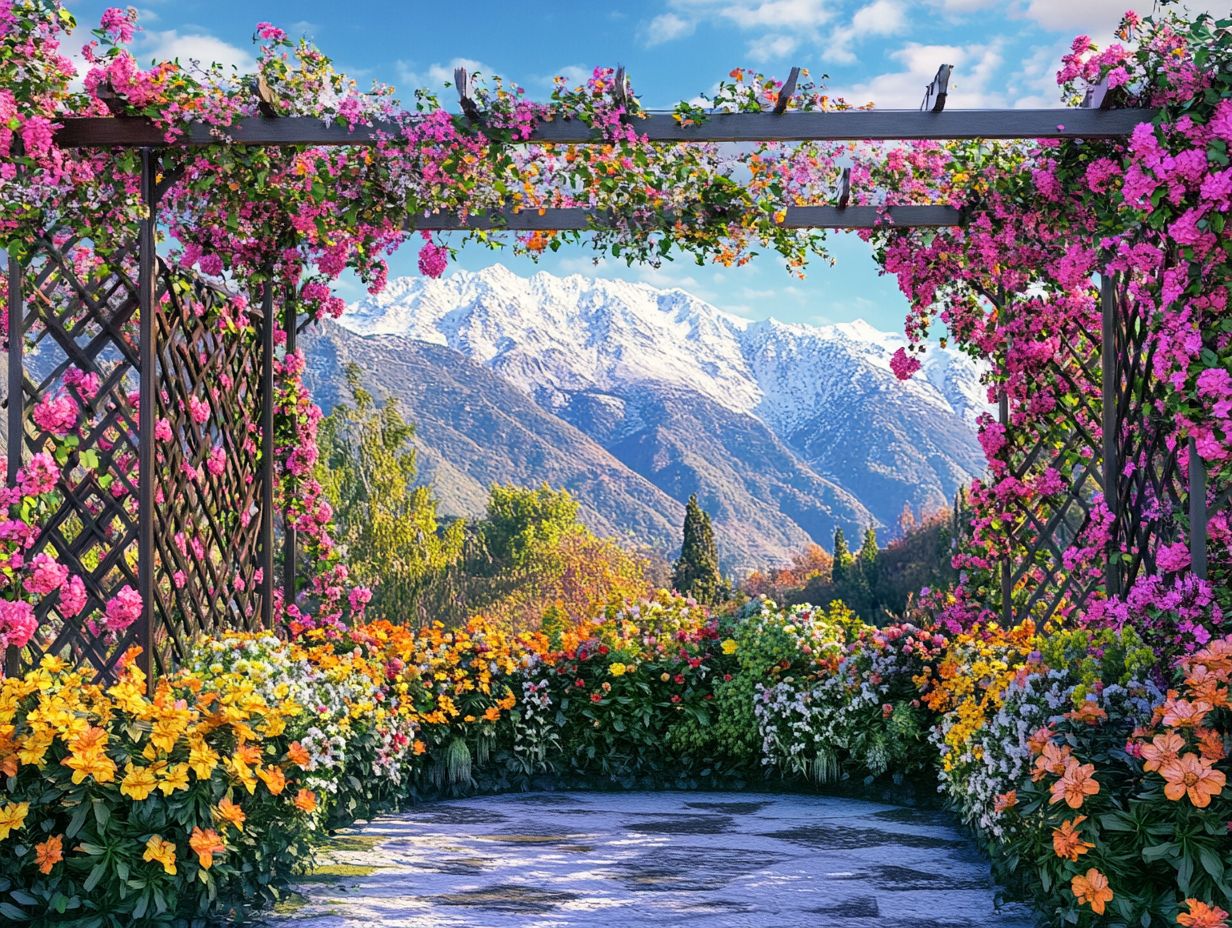
Consider climbing Snapdragon, a lesser-known yet enchanting biennial vine that can elevate your garden with vertical interest and vibrant color. It s especially lovely in designs that emphasize winter beauty and organic gardening principles.
This vine flourishes in moderate sunlight and well-drained soil, making it versatile enough to adapt to various garden conditions. Its fast-growing nature is perfect for trellises, fences, or mixed borders, allowing you to craft a lush, layered visual impact. When grouped with other colorful perennials, it provides height and enriches the overall texture of your landscape.
Adding organic mulch around its base will help retain moisture and suppress weeds, fostering healthier growth and a more dazzling display.
15. Climbing Nasturtium
Climbing Nasturtium, or Tropaeolum majus, is a splendid addition to your garden, celebrated for its vibrant edible flowers and resilience as a hardy flowering vine. This makes it an ideal choice for garden designs that prioritize both edible landscaping and winter interest.
This enchanting plant infuses your trellises, fences, and arbors with a burst of color and offers a tasty addition with its peppery leaves and blossoms. These can elevate your salads, sandwiches, and garnishes to a whole new level. As a garden enthusiast, you ll appreciate its low-maintenance nature; simply ensure it has well-drained soil and plenty of sunlight.
Its compatibility with other flowering species means it serves as an excellent companion plant, attracting beneficial pollinators like bees and butterflies while keeping certain pests at bay. In essence, this climbing beauty adds flavor, visual allure, and ecological advantages to your garden, transforming it into a thriving habitat.
What Are Climbing Plants and Why Are They Ideal for Cold Climates?
Climbing plants, especially those cold-hardy vines, are essential elements in garden design for colder climates. For more information on choosing the right plants for cold climates, they offer an impressive variety of native species that flourish across different USDA zones, delivering both aesthetic charm and ecological advantages.
Climbing plants allow you to make the most of limited space. They add visual interest to your landscape.
Their knack for climbing various structures whether trellises or walls makes them perfect for layering in your garden, creating privacy screens, and softening those harsh lines often found in urban settings.
But it s not just about looks. Climbing plants also provide insulation, helping to reduce heat loss in winter and offering shade during the warmer months. This enhances energy efficiency and lowers heating costs. By incorporating these hardy vines into your garden, you embrace a more sustainable approach, making them a wise choice for those who care about the environment.
What Are the Key Factors to Consider When Choosing Climbing Plants for Cold Climates?
When choosing climbing plants for cold climates, consider factors like hardiness, pruning needs, and your overall garden design. For the best results, look into the best vertical garden plants for cold climates to ensure that the cold-hardy vines you select will thrive and add some winter charm.
Understanding the specific hardiness zones is critical. Hardiness zones indicate how well plants can survive in various climates. Knowing your zone helps you choose plants that will thrive in your area. Sunlight exposure is equally important; some climbing plants bask happily in full sun, while others prefer the gentle caress of partial shade.
Maintenance is another factor to keep in mind. Some plants require minimal care, while others demand regular pruning to keep them looking their best. By incorporating these climbing plants into your landscape, you enhance visual appeal, creating stunning vertical elements that draw the eye and add texture to otherwise flat areas.
Ultimately, a thoughtfully curated selection of climbing plants can transform your garden space into a vibrant sanctuary.
How Can Climbing Plants Enhance the Aesthetics of a Garden in a Cold Climate?
Climbing plants can truly elevate the aesthetics of your garden in cold climates. They introduce vertical elements, vibrant colors, and ornamental flowers that create a lively landscape. For those looking to enhance their gardens, exploring the best plants for small cold-climate gardens is a great idea, ensuring they thrive even in frosty conditions.
These plants not only soften hardscapes but also breathe life into otherwise stark environments. Take climbing hydrangeas, for instance; they flourish along walls and offer large blooms in summer, while their lush foliage remains appealing through autumn. On the other hand, the vibrant red tendrils of the Virginia creeper provide a stunning burst of fall color, making them a standout choice for visual interest year-round.
By integrating these elements into both traditional and contemporary garden designs, you encourage a sense of depth and variety. This transforms simple patios into inviting retreats or charming escapes from the mundane. This thoughtful approach enriches your overall outdoor experience, making it all the more delightful.
What Are Some Tips for Maintaining Climbing Plants in a Cold Climate?
Maintaining climbing plants in cold climates requires a tailored approach. This includes proper pruning, the application of organic mulch, and an understanding of their unique winter interest needs, as well as considering the top 10 low-maintenance plants for cold climates to ensure healthy growth and longevity.
It’s crucial to monitor soil moisture levels closely. Well-watered plants can thrive even in winter’s chill. Water them deeply but infrequently, especially before the ground freezes. Feeding these climbing varieties with a balanced fertilizer which contains equal parts of key nutrients during the growing season will promote robust health. Attentive pest control will help prevent infestations that could compromise their structure.
Seasonal adjustments are also essential. Wrapping the base of your climbers with burlap provides protection from extreme cold. As winter approaches, ensuring they have adequate support and shelter will prepare these resilient plants for the colder months ahead.
How Can Climbing Plants Help with Insulation and Energy Efficiency in a Cold Climate?
Climbing plants are your secret weapon for natural insulation in colder climates. They enhance energy efficiency by curbing heat loss through walls, and by choosing the best plant varieties for cold climates, you can also add stunning visual interest during the winter months.
These lush vertical gardens can play a crucial role in stabilizing your indoor temperature, reducing the need for excessive heating when the chill sets in. Take ivy and wisteria, for instance; they beautifully drape over exterior surfaces and serve as a protective barrier against biting winter winds. Their leaves effectively trap air, creating a cozy layer of insulation perfect for sustainable garden designs.
Imagine the delightful fragrance of honeysuckle filling your garden in spring! This plant graces your space with fragrant blooms while contributing to energy efficiency all year round. By integrating climbing plants into your building facades, you can elevate aesthetic appeal and champion environmental sustainability simultaneously.
Frequently Asked Questions
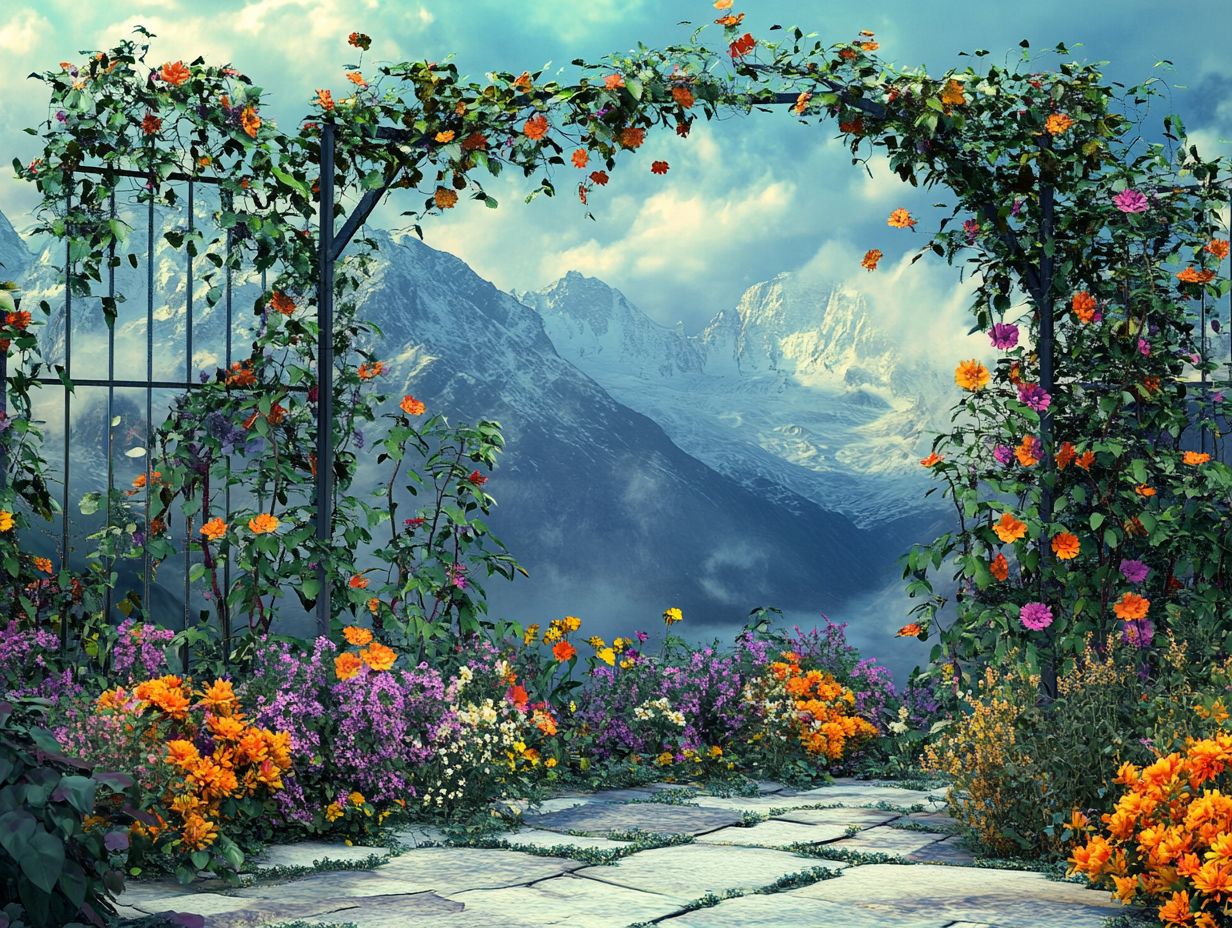
What are the best climbing plants for cold climates?
- Virginia creeper
- Clematis
- Honeysuckle
- Ivy
What should I consider when choosing climbing plants for a cold climate?
When selecting climbing plants, consider the temperature range they can survive in, as well as their ability to withstand frigid temperatures and harsh winds.
Can climbing plants survive in freezing temperatures?
Many climbing plants can survive and even thrive in freezing temperatures. However, it is important to choose the best foliage plants for cold climates that are specifically suited for these conditions.
How can I protect climbing plants in cold climates?
To protect climbing plants, use mulch or burlap to insulate the roots and stems from harsh temperatures. You can also grow them in containers that can be brought indoors during extreme cold snaps.
What are some fast-growing climbing plants for cold climates?
- Climbing roses
- Trumpet vine
- Wisteria
Can I grow fruit-bearing climbing plants in a cold climate?
Yes, there are several fruit-bearing climbing plants that can thrive in cold climates, such as kiwi vines, grape vines, and hardy varieties of raspberries and blackberries. For optimal success, consider the best indoor plants for cold climates and be sure to choose varieties suited for your specific temperature range.
Now that you know how climbing plants can enhance your garden’s energy efficiency, why not start planting them today? They can make a significant difference in both aesthetics and sustainability!

